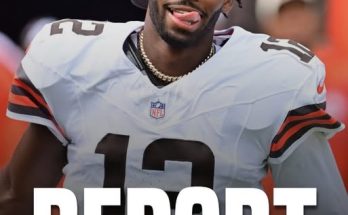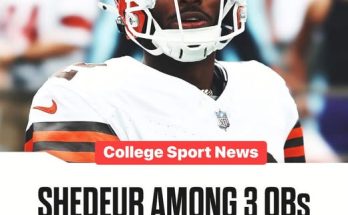Did the Cowboys’ Approach to Contract Extensions Provide the Ravens with a Model or Framework?
As the 2026 NFL offseason unfolds, every front office in the league is looking for the winning formula—how to retain their star players while maintaining long-term cap flexibility and building a championship roster. One team that has recently drawn attention for its strategic contract extension methodology is the Dallas Cowboys. Their proactive yet calculated approach to re-signing cornerstone players has sparked conversations across league offices, including inside the halls of the Baltimore Ravens’ front office. With key extensions looming—most notably quarterback Lamar Jackson’s future contract years, young stars like Kyle Hamilton, and other core contributors—the question must be asked: have the Cowboys, of all teams, provided a workable blueprint for the Ravens?
Dallas’s strategy has centered around three key pillars: early negotiation, cap manipulation via bonus structures, and an unapologetic focus on locking in a core group while drafting well to fill gaps around them. Whether it was extending Dak Prescott before the market fully ballooned, rewarding CeeDee Lamb’s production before his fifth-year option season, or structuring Micah Parsons’ upcoming mega-deal with forward-thinking cap flexibility, the Cowboys have shifted from reactive to proactive when managing their roster’s financial future.
Baltimore, historically, has taken a more conservative and balanced approach. General Manager Eric DeCosta, following in the footsteps of Ozzie Newsome, has been lauded for discipline, patience, and leveraging the compensatory draft pick formula. But as the league shifts toward massive quarterback salaries, skyrocketing wide receiver contracts, and shorter competitive windows, the Cowboys’ aggressiveness could represent a model worth adapting.
To understand if Baltimore might borrow from Dallas’s playbook, let’s examine how each element of the Cowboys’ strategy aligns—or clashes—with the Ravens’ core philosophy.
1. Early Negotiation and Market Prediction
Dallas’s willingness to engage in early extensions—often before a player reaches the end of their rookie deal—has saved them tens of millions. By extending Dak Prescott when they did, they avoided the burden of negotiating against an exploding quarterback market that now pays elite QBs north of $60 million annually. With players like CeeDee Lamb, they moved early enough to avoid competing with Justin Jefferson and Ja’Marr Chase-level deals.
Baltimore, in contrast, took a drawn-out, publicly debated approach with Lamar Jackson. Though they ultimately secured their franchise quarterback, the delay meant paying top-of-market value in 2023. It worked, but the tension and public nature of the negotiations could have been avoided had they followed a more proactive timeline.
With emerging young stars like Kyle Hamilton, Tyler Linderbaum, and possibly even Zay Flowers, early negotiations could offer massive savings and cement long-term team identity. If the Ravens internalize anything from Dallas, it should be this: pay your stars before the league resets the market again. The cost of waiting, especially in a rising salary cap environment, is steep.
2. Cap Structuring Through Signing Bonuses and Void Years
The Cowboys have also been aggressive in their use of signing bonuses, converting base salaries into prorated bonuses to manipulate cap hits and spread financial impact over multiple seasons. It’s a high-risk, high-reward move: flexibility now in exchange for “dead money” later. They also leverage void years, a tactic that allows cap numbers to be spread even further without locking the player in contractually beyond a reasonable window.
This is an area where Baltimore has been more reserved. The Ravens rarely use void years and prefer more linear structures to protect against dead cap down the line. However, in a league where $35 million cap hits for a defensive tackle or $60 million annual salaries for quarterbacks are becoming the norm, it may be time for Baltimore to adjust.
If the Ravens want to keep this core together—especially with Lamar Jackson’s cap number escalating in coming years—they’ll need to become more comfortable using modern tools of cap management. The Cowboys have shown that with the right balance, even aggressive structuring can keep a competitive roster intact. Look no further than how they managed to retain Zack Martin, DeMarcus Lawrence, and Trevon Diggs in back-to-back offseasons without gutting the rest of the team.
3. Lock in a Core and Supplement Through Draft and Development
Perhaps the most critical part of Dallas’s strategy—one the Ravens already mirror well—is defining and committing to a core. The Cowboys identified their foundational players early: Dak, Parsons, Lamb, Martin, and Diggs. Around that, they’ve focused on drafting and developing cheap, effective role players to support them. This not only balances the salary cap but creates continuity across systems and leadership groups.
This is where the Ravens already excel. Few teams draft and develop as consistently as Baltimore. Whether it’s finding Pro Bowlers in Round 1 (Hamilton, Linderbaum), snagging value in the mid-rounds (Brandon Stephens, Travis Jones), or developing undrafted contributors, the Ravens know how to build from within. If anything, the Cowboys’ approach reaffirms the validity of this method—and underscores the importance of keeping that core intact, even if it means pushing cap boundaries.
Where Dallas may outpace Baltimore is in decisiveness. When the Cowboys commit, they don’t waver. There’s no public waffling. There are fewer drawn-out negotiations. They act quickly, signal loyalty, and move forward. In a media-saturated environment like the NFL, that decisiveness helps maintain locker room unity and public confidence. Baltimore could benefit from adopting a bit more of that clarity.
Challenges and Risks
While the Cowboys’ strategy offers lessons, it’s not without drawbacks—and the Ravens must tread carefully if they hope to learn from it without repeating its mistakes.
For one, Dallas has consistently sacrificed future cap health for short-term flexibility. This could become problematic if the roster ages out or if their drafts stop producing starters. The Ravens, with their more conservative structures, rarely find themselves in cap purgatory.
Second, Dallas’s model works only if the core performs. Overpaying one player—especially at a volatile position like wide receiver or running back—can cripple cap structure. The Ravens will need to be ruthlessly honest about who belongs in the “core” and who is expendable.
Lastly, the Cowboys have yet to win big with this model. Playoff shortcomings still hang over the strategy. For Baltimore to adopt a similar blueprint, it must be viewed not just as a way to stay competitive, but as a means to build a champion.
Looking Ahead: What the Ravens Could (and Should) Do
As the 2026 season approaches, Baltimore faces several pivotal decisions that could define the next five years of its roster.
Lamar Jackson’s cap hit will rise soon. The Ravens must decide whether to restructure his deal for flexibility or ride it out and limit future moves.
Kyle Hamilton is eligible for extension next year. Based on his performance, he’ll demand top-tier safety money. Waiting too long may mean paying even more.
Tyler Linderbaum, Zay Flowers, and David Ojabo are all progressing toward key evaluation points. Deciding who earns long-term commitments—and at what price—will shape Baltimore’s future.
The wide receiver room, long a source of frustration, may finally be stabilizing. If the Ravens believe in Flowers or another breakout WR, striking early before the WR market spikes again (as expected) could save millions.
The question isn’t whether the Ravens should take cues from Dallas—it’s whether they can adapt the principles without abandoning their identity. The Cowboys have shown that being aggressive, early, and creative with contracts doesn’t mean sacrificing your team’s soul. It means evolving with the league.
Conclusion
The Cowboys’ contract extension strategy has provided a new kind of template for NFL teams navigating the modern salary cap era. It rewards loyalty early, leverages financial tools to retain top talent, and maximizes the prime years of a core group. While it comes with risk, it also brings opportunity—a reality the Ravens can no longer ignore.
Baltimore has always done things its own way: measured, disciplined, and grounded in homegrown talent. But as the cost of elite play rises and championship windows narrow, learning from Dallas—taking the bones of their model and refining it through a Ravens lens—might be the bold, calculated step needed to keep this team at the top.
Whether it’s locking in Kyle Hamilton, restructuring Lamar Jackson, or identifying the next core star to bet on, the Ravens have some major decisions ahead. And in the chessboard of NFL roster building, borrowing a few strategic moves from Dallas might be what gets them to checkmate.



